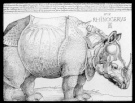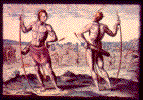Manuscripts, Books, and Maps: The Printing Press and a Changing World
The Rise of Vernacular Languages and Nation States and
the Decline of the Roman Catholic Church.
The power of the Roman Catholic Church was based in part on the ability
of the church to enforce the use of Latin as the language for the
worship of God. Just as the manuscript books were the main visual
means of venerating God, so to Latin was the only verbal means of
communicating with him. In
Imagined Communities,
Benedict Anderson notes, that as long as the Church could maintain this
link, and as long as it controlled who learned to speak and write
Latin, the Church could maintain its position in the world.
With Latin was the only language for religious texts, the priest
represented the only true path to God and way to salvation.
Through that link, the Church maintainedits political power in the
world.
The concept of Latin as the only language appropriate to worship in, or
the only path to God, was challenged by Luther. His challenge was
fostered and enlarged by books, most notably Bibles and prayer books,
in vernacular languages.
At this time there is also the expansion by Western Europe into Africa
and the New World. Prince Henry of Portugal
(Henry the Navigator) sends his
fleets to explore the coast of Africa in the 1440s and Columbus falls
into history by stumbling over the America's at the end of the
century.
One of the consequences of this push into the world is that books
become a way of disseminating information about the outside world; new
information about a new world that Europe was very curious about.
Given that most of the artists and authors had not traveled to the New
World to see for themselves, they were forced to rely on the
descriptions of those who had made the journeys. This led to some
interesting representations of faraway places.
 Durer, like other artists and printmakers
of his age, suffered under the lack of
information. His information about animals in other parts of the world
came from written descriptions. However, as time progresses, there is
a development of Durer's artistic sensibility.
Durer, like other artists and printmakers
of his age, suffered under the lack of
information. His information about animals in other parts of the world
came from written descriptions. However, as time progresses, there is
a development of Durer's artistic sensibility.
 Note both the difference in appearance, and the development of Durer's
talent, shown between this image and the one of the pig above. There
are also attempts to show the strange people who populate the New
World. Like the "Christ in the Walker" image above, many of these
visions were juxtapositions of what might be found in the New World,
represented in terms of what people in the old world were more
accustomed.
Note both the difference in appearance, and the development of Durer's
talent, shown between this image and the one of the pig above. There
are also attempts to show the strange people who populate the New
World. Like the "Christ in the Walker" image above, many of these
visions were juxtapositions of what might be found in the New World,
represented in terms of what people in the old world were more
accustomed.
In the art of this time,
there was a distortion of perception and an inability to incorporate
novelty that made it difficult for Europeans to put all of their
understanding of the world within this new kind of a printed frame.
And, just as the flora and fauna of the New World was both frightening
and fanciful, so too were the inhabitants.

|

|

|
| A Weroans or gread Lord of Virginia.
| The manner of making their boats
| How the slave who had spoken ill of me was himself eaten
|
These images are from Theodore De Bry's,
Historica Americae.
While the work was intended to portray life in the Americas,
"A Weroans or gread Lord of Virginia," was created with the
aesthetic sensibility of Greek statues or Renaissance anatomy
studies - front and rear views.
As can be seen in the other two images,
"The manner of making their boats" and
"How the slave who had spoken ill of me was himself eaten,"
the same sensibilities carried over into De Bry's studies of culture.
These were the ways in which people tried to put new information into
print, but there was a conservatism in the images as well.
By far, the biggest effect of the universities, print books and an
increasingly literate reading public, came in the emerging scientific
fields of botany, geography, and astronomy.
In large part, the rise of Science as a replacement for religion as a
way of seeing the world has to do with the changing nature of
libraries. Instead of a few repositories, usually in the control of
the church, people began to accumulate private libraries.
One of Eisenstein's points is that mis-information in books was
impossible to spot until you could gather a stack of books together on
the table and do comparisons. In much the same way that literacy
allows for critical reflection, print books pushed this ability into a
new dimension. For the first time private individuals could gather a
collection of books which allowed them to examine a range of opinions
and attempt to fix invariances in the world. In this case, the
knowledge that underlie an emerging science did not have to come from
direct experience in the world, but could instead come from experience
with books.
In the early 13th century, science got a boost from the Crusaders
returning from the Holy Land. These men brought back copies of the
texts of the Greeks and Romans, lost to European audiences since the
fall of Rome. Included in those texts were science texts from the
Greeks.
When printing makes copies of these books available to a wider
audience, and makes it possible to do comparison between books, the
comparison of these ideas leads to new ideas.
 This is a surveying exercise from a Dutch book on science by Ezechiel
de Decker,
De Arithmetrica
.
This is a surveying exercise from a Dutch book on science by Ezechiel
de Decker,
De Arithmetrica
.
This leads to new books on scientific subjects, when, by the 15th
century, there are new books on science, mathematics, and military
engineering.
Goto the next chapter
Return to the Books Table of Contents
This page last updated on:
Jan 30 1997
 Durer, like other artists and printmakers
of his age, suffered under the lack of
information. His information about animals in other parts of the world
came from written descriptions. However, as time progresses, there is
a development of Durer's artistic sensibility.
Durer, like other artists and printmakers
of his age, suffered under the lack of
information. His information about animals in other parts of the world
came from written descriptions. However, as time progresses, there is
a development of Durer's artistic sensibility.




